2022 TOYOTA PROACE CITY VERSO EV change time
[x] Cancel search: change timePage 145 of 320

145
Driving
6
Push selector
P.Auto ParkPress this button to switch to Parking mode.For parking the vehicle: the front wheels are blocked.
R.Reverse
N.NeutralTo free-wheel and move the vehicle, with the ignition off.For more information on Free-wheeling, refer to the corresponding section.
D.Driving in automatic modeThe gearbox manages gear changes according to the style of driving, the road profile and the vehicle load.
M.Driving in manual mode (Petrol/Diesel)Press this button to switch to manual mode.The driver changes gear using the steering-
mounted controls.
► In mode N, with your foot on the brake pedal, push without passing the point of resistance:• Forwards, mode R is selected.
• Backwards, mode D is selected.Release the selector fully after each push; it will then return to its initial position.
Special cases
To avoid mode N (quick change from D to R and back again):► In mode R, push backwards past the point of resistance, mode D is selected.► In mode D, push forwards past the point of resistance, mode R is selected.► To return to mode N, push without passing the point of resistance.
Steering-mounted controls
(Depending on equipment)In mode M or D, the steering-mounted control paddles can be used to change gear manually.They cannot be used to select neutral or to engage or disengage reverse gear.
► Pull the "+" or "-" paddle towards you and release to shift up or down a gear, respectively.
Information displayed on
the instrument panel
When the ignition is switched on, the gearbox status is displayed on the instrument panel:
PParking
RReverse
NNeutral
D1...8Automatic forward gear
M1...8Manual forward gear
The state of the gearbox remains displayed on the instrument panel for a few seconds after switching off the ignition.
Operation
Only appropriate mode change instructions are validated.With the engine running, if it is necessary to depress the brake pedal to change modes, an alert message will be displayed on the instrument panel.
WARNI NG
With the engine running and the brakes released, if R, D or M is selected, the vehicle moves off, even without pressing the accelerator pedal.Never depress the accelerator and brake pedals at the same time - risk of damage to the gearbox!
Page 146 of 320
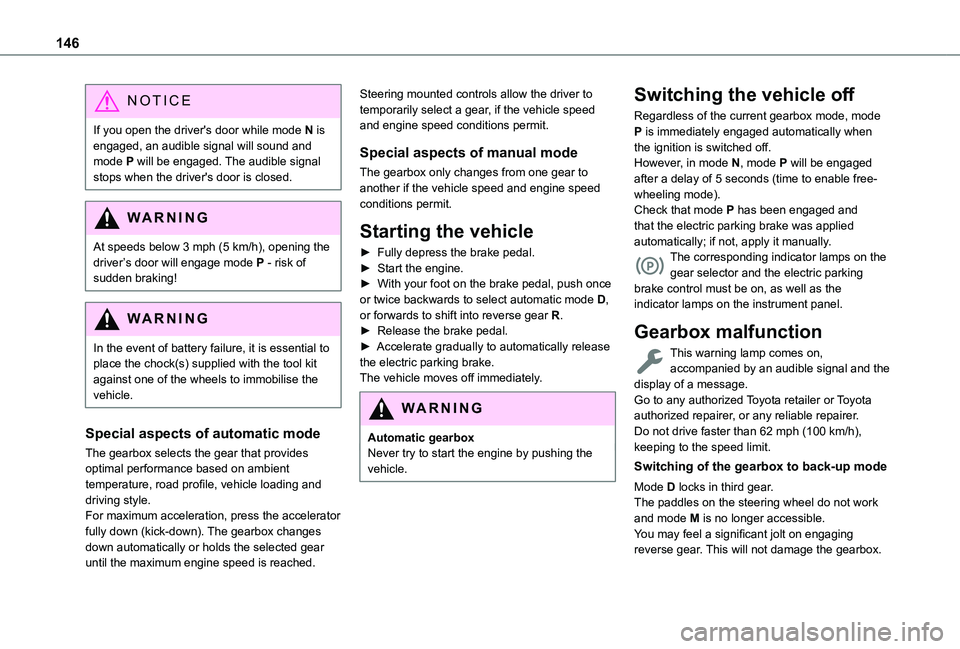
146
NOTIC E
If you open the driver's door while mode N is engaged, an audible signal will sound and mode P will be engaged. The audible signal stops when the driver's door is closed.
WARNI NG
At speeds below 3 mph (5 km/h), opening the driver’s door will engage mode P - risk of sudden braking!
WARNI NG
In the event of battery failure, it is essential to place the chock(s) supplied with the tool kit against one of the wheels to immobilise the vehicle.
Special aspects of automatic mode
The gearbox selects the gear that provides optimal performance based on ambient temperature, road profile, vehicle loading and driving style.For maximum acceleration, press the accelerator fully down (kick-down). The gearbox changes
down automatically or holds the selected gear until the maximum engine speed is reached.
Steering mounted controls allow the driver to temporarily select a gear, if the vehicle speed and engine speed conditions permit.
Special aspects of manual mode
The gearbox only changes from one gear to another if the vehicle speed and engine speed conditions permit.
Starting the vehicle
► Fully depress the brake pedal.► Start the engine.► With your foot on the brake pedal, push once or twice backwards to select automatic mode D, or forwards to shift into reverse gear R.► Release the brake pedal.► Accelerate gradually to automatically release the electric parking brake.The vehicle moves off immediately.
WARNI NG
Automatic gearbox
Never try to start the engine by pushing the vehicle.
Switching the vehicle off
Regardless of the current gearbox mode, mode P is immediately engaged automatically when the ignition is switched off.However, in mode N, mode P will be engaged after a delay of 5 seconds (time to enable free-wheeling mode).Check that mode P has been engaged and that the electric parking brake was applied automatically; if not, apply it manually.The corresponding indicator lamps on the gear selector and the electric parking brake control must be on, as well as the indicator lamps on the instrument panel.
Gearbox malfunction
This warning lamp comes on, accompanied by an audible signal and the display of a message.Go to any authorized Toyota retailer or Toyota authorized repairer, or any reliable repairer.Do not drive faster than 62 mph (100 km/h),
keeping to the speed limit.
Switching of the gearbox to back-up mode
Mode D locks in third gear.The paddles on the steering wheel do not work and mode M is no longer accessible.You may feel a significant jolt on engaging reverse gear. This will not damage the gearbox.
Page 151 of 320
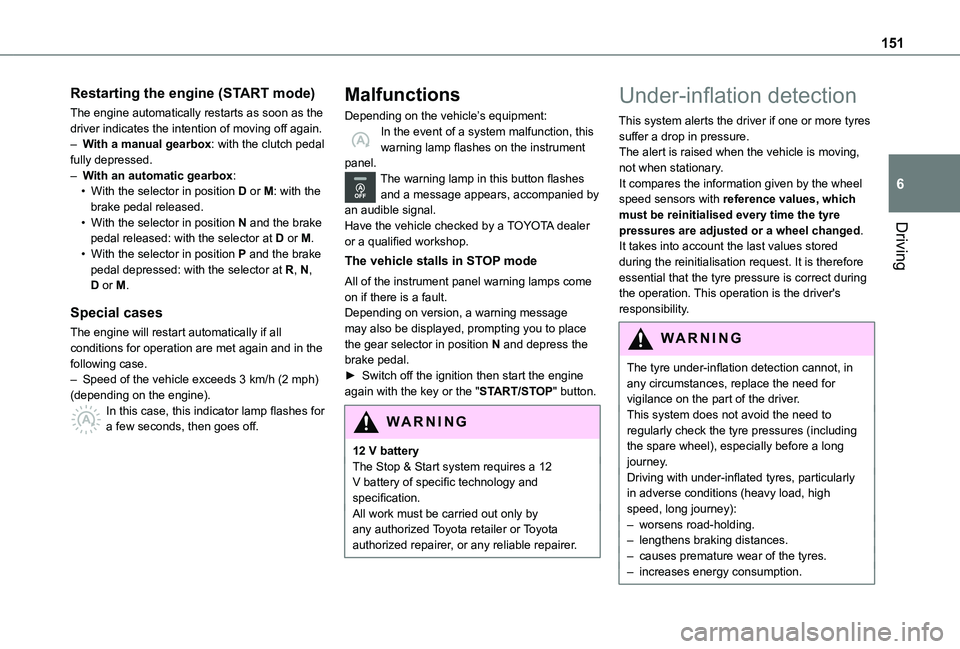
151
Driving
6
Restarting the engine (START mode)
The engine automatically restarts as soon as the driver indicates the intention of moving off again.– With a manual gearbox: with the clutch pedal fully depressed.– With an automatic gearbox:• With the selector in position D or M: with the brake pedal released.• With the selector in position N and the brake pedal released: with the selector at D or M.• With the selector in position P and the brake pedal depressed: with the selector at R, N, D or M.
Special cases
The engine will restart automatically if all conditions for operation are met again and in the following case.– Speed of the vehicle exceeds 3 km/h (2 mph) (depending on the engine).In this case, this indicator lamp flashes for a few seconds, then goes off.
Malfunctions
Depending on the vehicle’s equipment:In the event of a system malfunction, this warning lamp flashes on the instrument panel.The warning lamp in this button flashes and a message appears, accompanied by an audible signal.Have the vehicle checked by a TOYOTA dealer or a qualified workshop.
The vehicle stalls in STOP mode
All of the instrument panel warning lamps come on if there is a fault.Depending on version, a warning message may also be displayed, prompting you to place the gear selector in position N and depress the brake pedal.► Switch off the ignition then start the engine again with the key or the "START/STOP" button.
WARNI NG
12 V batteryThe Stop & Start system requires a 12 V battery of specific technology and specification.All work must be carried out only by any authorized Toyota retailer or Toyota authorized repairer, or any reliable repairer.
Under-inflation detection
This system alerts the driver if one or more tyres suffer a drop in pressure.The alert is raised when the vehicle is moving, not when stationary.It compares the information given by the wheel speed sensors with reference values, which must be reinitialised every time the tyre pressures are adjusted or a wheel changed.It takes into account the last values stored during the reinitialisation request. It is therefore essential that the tyre pressure is correct during the operation. This operation is the driver's responsibility.
WARNI NG
The tyre under-inflation detection cannot, in any circumstances, replace the need for vigilance on the part of the driver.This system does not avoid the need to regularly check the tyre pressures (including the spare wheel), especially before a long journey.Driving with under-inflated tyres, particularly in adverse conditions (heavy load, high speed, long journey):– worsens road-holding.– lengthens braking distances.– causes premature wear of the tyres.– increases energy consumption.
Page 158 of 320
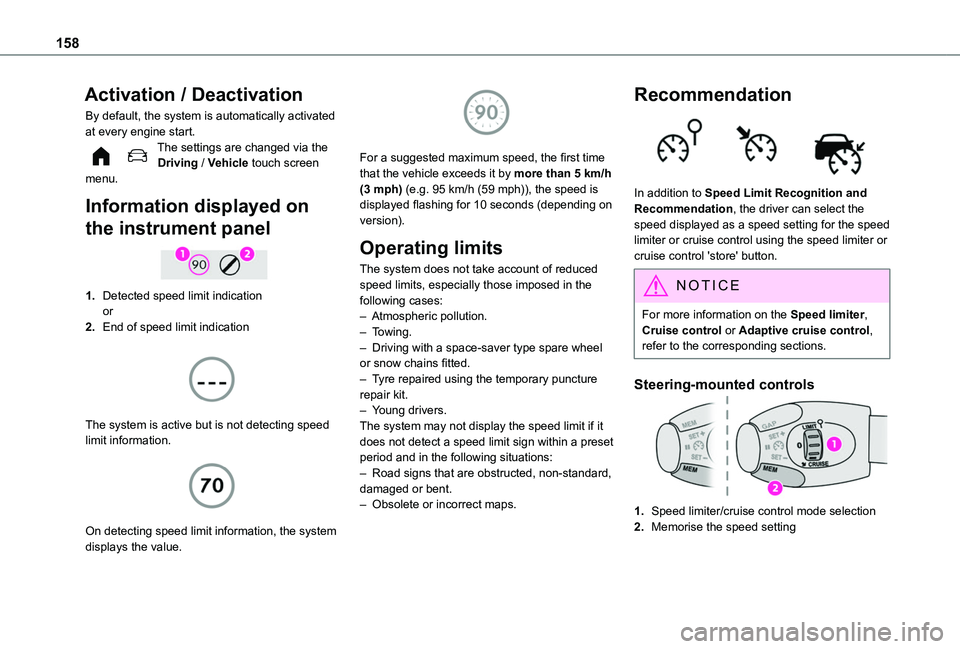
158
Activation / Deactivation
By default, the system is automatically activated at every engine start.The settings are changed via the Driving / Vehicle touch screen menu.
Information displayed on
the instrument panel
1.Detected speed limit indicationor
2.End of speed limit indication
The system is active but is not detecting speed limit information.
On detecting speed limit information, the system
displays the value.
For a suggested maximum speed, the first time that the vehicle exceeds it by more than 5 km/h (3 mph) (e.g. 95 km/h (59 mph)), the speed is displayed flashing for 10 seconds (depending on version).
Operating limits
The system does not take account of reduced speed limits, especially those imposed in the following cases:– Atmospheric pollution.– Towing.– Driving with a space-saver type spare wheel or snow chains fitted.– Tyre repaired using the temporary puncture repair kit.– Young drivers.The system may not display the speed limit if it does not detect a speed limit sign within a preset period and in the following situations:– Road signs that are obstructed, non-standard, damaged or bent.– Obsolete or incorrect maps.
Recommendation
In addition to Speed Limit Recognition and Recommendation, the driver can select the speed displayed as a speed setting for the speed limiter or cruise control using the speed limiter or cruise control 'store' button.
NOTIC E
For more information on the Speed limiter, Cruise control or Adaptive cruise control, refer to the corresponding sections.
Steering-mounted controls
1.Speed limiter/cruise control mode selection
2.Memorise the speed setting
Page 172 of 320
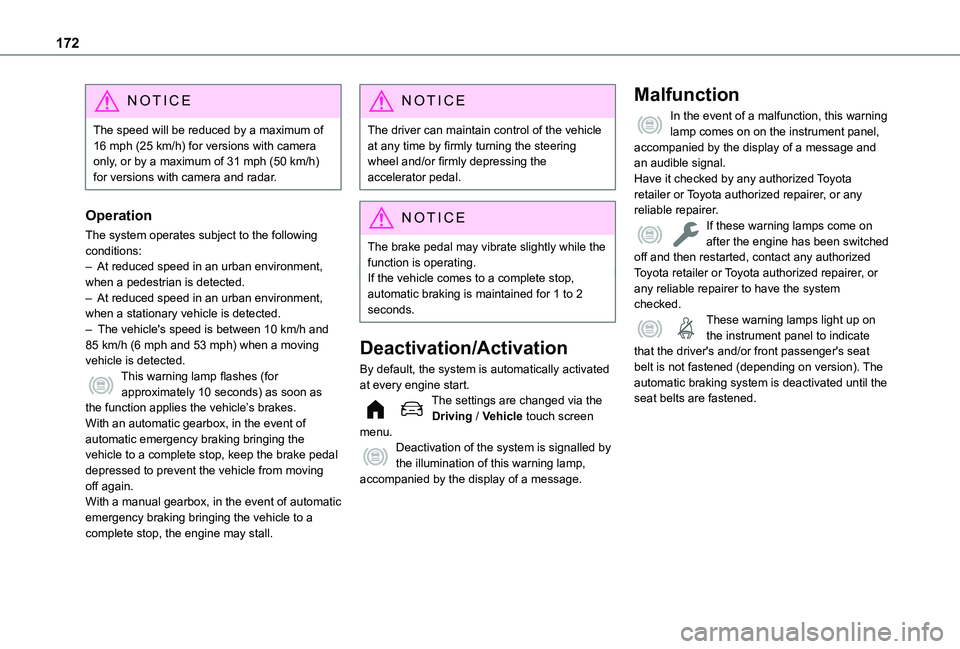
172
NOTIC E
The speed will be reduced by a maximum of 16 mph (25 km/h) for versions with camera only, or by a maximum of 31 mph (50 km/h) for versions with camera and radar.
Operation
The system operates subject to the following conditions:– At reduced speed in an urban environment, when a pedestrian is detected.– At reduced speed in an urban environment, when a stationary vehicle is detected.– The vehicle's speed is between 10 km/h and 85 km/h (6 mph and 53 mph) when a moving vehicle is detected.This warning lamp flashes (for approximately 10 seconds) as soon as the function applies the vehicle’s brakes.With an automatic gearbox, in the event of automatic emergency braking bringing the
vehicle to a complete stop, keep the brake pedal depressed to prevent the vehicle from moving off again.With a manual gearbox, in the event of automatic emergency braking bringing the vehicle to a complete stop, the engine may stall.
NOTIC E
The driver can maintain control of the vehicle at any time by firmly turning the steering wheel and/or firmly depressing the accelerator pedal.
NOTIC E
The brake pedal may vibrate slightly while the function is operating.If the vehicle comes to a complete stop, automatic braking is maintained for 1 to 2 seconds.
Deactivation/Activation
By default, the system is automatically activated at every engine start.The settings are changed via the Driving / Vehicle touch screen menu.Deactivation of the system is signalled by the illumination of this warning lamp, accompanied by the display of a message.
Malfunction
In the event of a malfunction, this warning lamp comes on on the instrument panel, accompanied by the display of a message and an audible signal.Have it checked by any authorized Toyota retailer or Toyota authorized repairer, or any reliable repairer.If these warning lamps come on after the engine has been switched off and then restarted, contact any authorized Toyota retailer or Toyota authorized repairer, or any reliable repairer to have the system checked.These warning lamps light up on the instrument panel to indicate that the driver's and/or front passenger's seat belt is not fastened (depending on version). The automatic braking system is deactivated until the seat belts are fastened.
Page 177 of 320
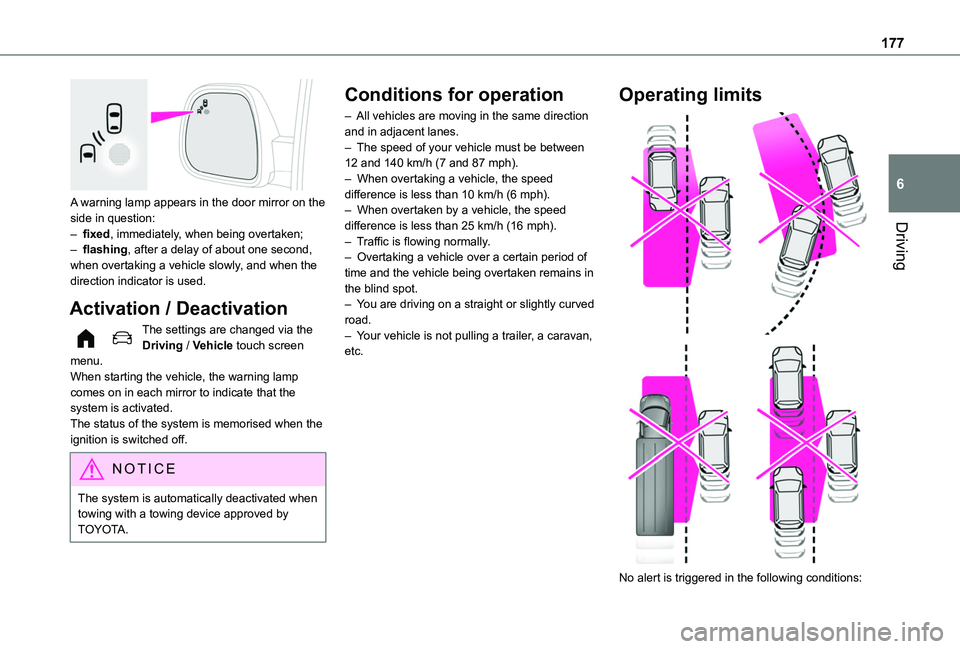
177
Driving
6
A warning lamp appears in the door mirror on the side in question:– fixed, immediately, when being overtaken;– flashing, after a delay of about one second, when overtaking a vehicle slowly, and when the direction indicator is used.
Activation / Deactivation
The settings are changed via the Driving / Vehicle touch screen menu.When starting the vehicle, the warning lamp comes on in each mirror to indicate that the system is activated.The status of the system is memorised when the ignition is switched off.
NOTIC E
The system is automatically deactivated when towing with a towing device approved by TOYOTA.
Conditions for operation
– All vehicles are moving in the same direction and in adjacent lanes.– The speed of your vehicle must be between 12 and 140 km/h (7 and 87 mph).– When overtaking a vehicle, the speed difference is less than 10 km/h (6 mph).– When overtaken by a vehicle, the speed difference is less than 25 km/h (16 mph).– Traffic is flowing normally.– Overtaking a vehicle over a certain period of time and the vehicle being overtaken remains in the blind spot.– You are driving on a straight or slightly curved road.– Your vehicle is not pulling a trailer, a caravan, etc.
Operating limits
No alert is triggered in the following conditions:
Page 178 of 320
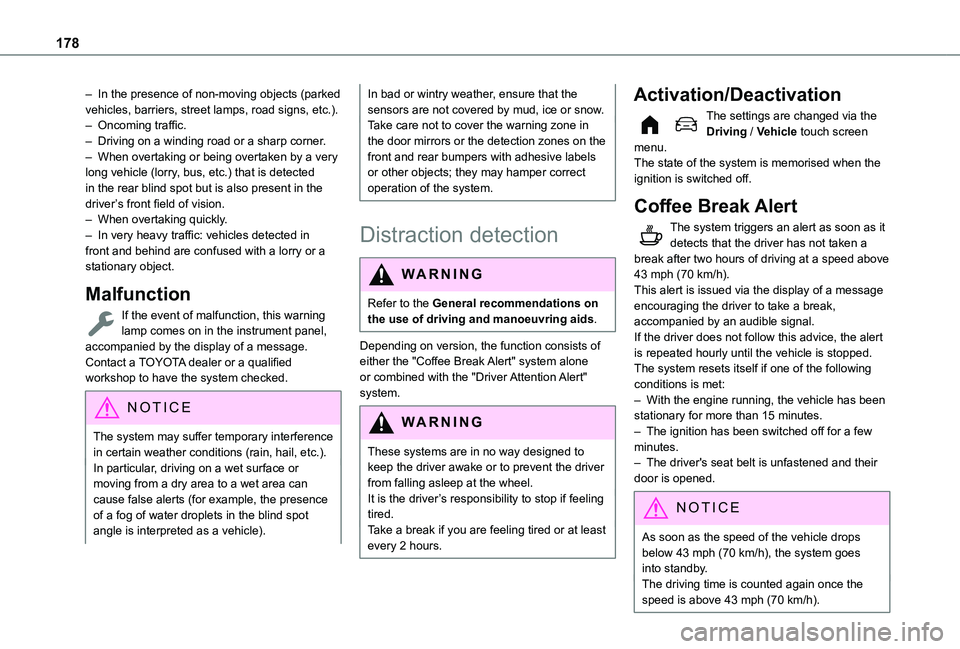
178
– In the presence of non-moving objects (parked vehicles, barriers, street lamps, road signs, etc.).– Oncoming traffic.– Driving on a winding road or a sharp corner.– When overtaking or being overtaken by a very long vehicle (lorry, bus, etc.) that is detected in the rear blind spot but is also present in the driver’s front field of vision.– When overtaking quickly.– In very heavy traffic: vehicles detected in front and behind are confused with a lorry or a stationary object.
Malfunction
If the event of malfunction, this warning lamp comes on in the instrument panel, accompanied by the display of a message.Contact a TOYOTA dealer or a qualified workshop to have the system checked.
NOTIC E
The system may suffer temporary interference in certain weather conditions (rain, hail, etc.).In particular, driving on a wet surface or moving from a dry area to a wet area can cause false alerts (for example, the presence of a fog of water droplets in the blind spot angle is interpreted as a vehicle).
In bad or wintry weather, ensure that the sensors are not covered by mud, ice or snow.Take care not to cover the warning zone in the door mirrors or the detection zones on the front and rear bumpers with adhesive labels or other objects; they may hamper correct operation of the system.
Distraction detection
WARNI NG
Refer to the General recommendations on the use of driving and manoeuvring aids.
Depending on version, the function consists of either the "Coffee Break Alert" system alone or combined with the "Driver Attention Alert" system.
WARNI NG
These systems are in no way designed to keep the driver awake or to prevent the driver from falling asleep at the wheel. It is the driver’s responsibility to stop if feeling tired.Take a break if you are feeling tired or at least
every 2 hours.
Activation/Deactivation
The settings are changed via the Driving / Vehicle touch screen menu.The state of the system is memorised when the ignition is switched off.
Coffee Break Alert
The system triggers an alert as soon as it detects that the driver has not taken a break after two hours of driving at a speed above 43 mph (70 km/h).This alert is issued via the display of a message encouraging the driver to take a break, accompanied by an audible signal.If the driver does not follow this advice, the alert is repeated hourly until the vehicle is stopped.The system resets itself if one of the following conditions is met:– With the engine running, the vehicle has been stationary for more than 15 minutes.– The ignition has been switched off for a few
minutes.– The driver's seat belt is unfastened and their door is opened.
NOTIC E
As soon as the speed of the vehicle drops below 43 mph (70 km/h), the system goes into standby.The driving time is counted again once the speed is above 43 mph (70 km/h).
Page 186 of 320
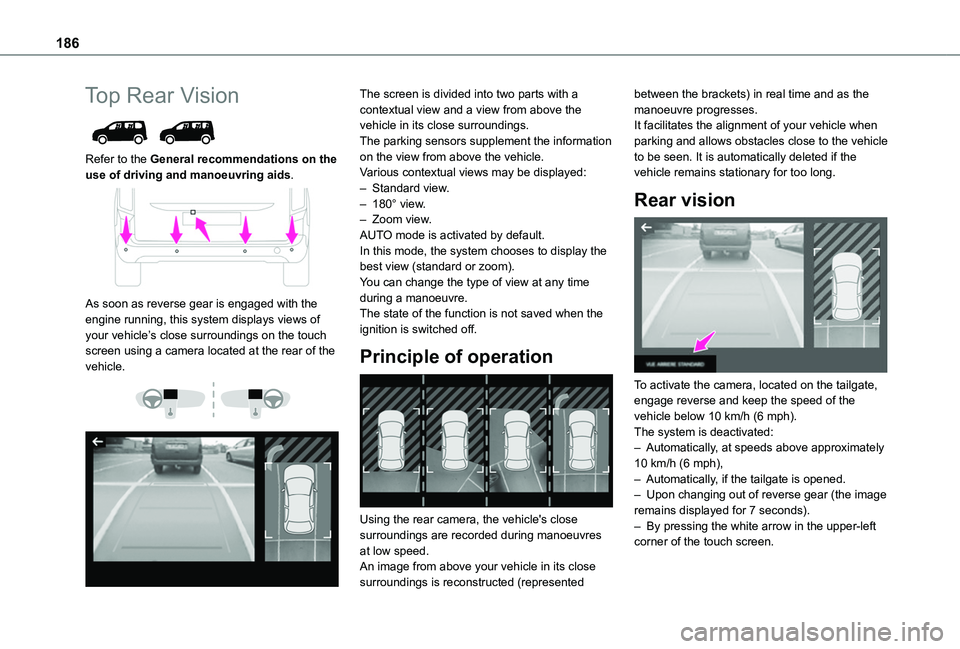
186
Top Rear Vision
Refer to the General recommendations on the use of driving and manoeuvring aids.
As soon as reverse gear is engaged with the engine running, this system displays views of your vehicle’s close surroundings on the touch screen using a camera located at the rear of the vehicle.
The screen is divided into two parts with a contextual view and a view from above the vehicle in its close surroundings.The parking sensors supplement the information on the view from above the vehicle.Various contextual views may be displayed:– Standard view.– 180° view.– Zoom view.AUTO mode is activated by default.In this mode, the system chooses to display the best view (standard or zoom).You can change the type of view at any time during a manoeuvre.The state of the function is not saved when the ignition is switched off.
Principle of operation
Using the rear camera, the vehicle's close surroundings are recorded during manoeuvres
at low speed.An image from above your vehicle in its close surroundings is reconstructed (represented
between the brackets) in real time and as the manoeuvre progresses.It facilitates the alignment of your vehicle when parking and allows obstacles close to the vehicle to be seen. It is automatically deleted if the vehicle remains stationary for too long.
Rear vision
To activate the camera, located on the tailgate, engage reverse and keep the speed of the vehicle below 10 km/h (6 mph).The system is deactivated:– Automatically, at speeds above approximately 10 km/h (6 mph),– Automatically, if the tailgate is opened.– Upon changing out of reverse gear (the image remains displayed for 7 seconds).– By pressing the white arrow in the upper-left corner of the touch screen.